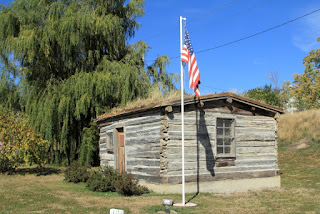After entering the museum I was greeted by Tom Rancour, the museum owner. Tom and I hit it off right away because Tom earned his bachelor's and master's degrees in civil engineering from the South Dakota School of Mines & Technology. After graduation, Tom decided to take a job working as a forensic engineer, which is what he still does when he is not at the museum.
Over the years as Tom traveled from place-to-place for his job, he started collecting military equipment until he finally realized that he had collected so many items that he needed to start his own museum. Since he liked small towns, the Armed Forces Display and Gift Shop museum ended up being located in Wasta.
Next stop - Wall. Whenever we pass through Wall we always have to visit Wall Drug, where they give free coffee and doughnuts to veterans. When we went to get our free doughnuts, I asked the young girl at the counter if she wanted to see our DD-214s and she said: "Oh No! We trust you!" I forgot that I was in South Dakota!
 |
| File Picture - Wall Drug Dinosaur |
 |
| File Picture |
The National Grasslands Visitor Center is also located in Wall, just down the street from Wall Drug. The Center contains information about the 20 National Grasslands in Western United States and displays about the plants and wildlife in each area. There is also information about the Midewin National Tallgrass Prairie.
The Minuteman Missile National Historic Site Visitor Center is located on the north side of Interstate 90 at Exit 131, east of Wall. This is also the place where you get tickets for the guided tour of a Minuteman Missile Silo that has been deactivated. (Similar to the Minuteman Missile Silo that is part of the Ellsworth Air Force Base tour.) Tickets are very difficult to obtain, so you need to be in line at the visitor center early in the morning on the day of the tour. For those visitors that cannot obtain tickets, a self-guided surface only tour is available at a different location (obtain information at the visitor center); or during the summer months, it is easier to just take the tour at Ellsworth Air Force Base.
The Edgar Brown Sod House and Homestead is located on the south side of Interstate 90, also at Exit 131. The Brown family moved to this location in 1909 and the sod house was their first and only house that they built on the homestead. The house was built into the side of a hill and had sod walls, dirt floors, and a dirt roof. Several other farm buildings are also located on the site and open to the public.
Their horse is not looking too well these days and just up the road at Cactus Flat Prairie Dog Town is one of the largest prairie dogs that I have ever seen! (Since this exhibit is a private enterprise, kids can purchase food at the store and feed the prairie dogs.)
The community of Philip is located along U.S. Highway 14 about half way between Pierre and Rapid city and is known at the place "Where the Sun Kisses the Earth." Farming is prevalent in the area and the grain elevator is still active.
Lincoln McIlravy is probably the most famous person from Philip. Lincoln wrestled for Philip High School and won 5 state titles and then went on to win a Bronze Medal in wrestling at the 2000 Summer Olympic Games in Sydney, Australia.
Philip also has a nice Veterans Memorial and the historic Molyneux Cabin is located just north of Main Street. The Molyneux Cabin was constructed in 1888 somewhere in the Black Hills and then moved to Haakon County in 1896 and used as a school for three terms. Molyneux was the name of the teacher.
Midland is located about 25 miles east of Philip and has a more modern designed grain elevator that is painted white. There is also an old abandoned traditional grain elevator located north of the railroad track.
The original 1907 Chicago & Northwestern railroad depot has been converted into a pioneer museum known as the "Biggest Little Museum in the West."
Located about 1.5 miles south of Hayes Junction on U.S. Highway 14 is an interesting marker that I have never noticed before, even though I have probably driven by it a hundred times.
The marker states that this was the location of the Plum Creek [Stagecoach] Station from 1878 to 1886 and the place where the stagecoach changed horses. Plum Creek Station was considered to be the "best waterhole in the territory" and also had a telegraph station and road ranch. Three famous trails crossed at this location - The Deadwood Trail from Pierre to Deadwood, Fort Bennett Army Trail to Nebraska, and the Cherry Creek Indian Trail to Rosebud.
When I arrived at the farm, I almost did not recognize the place because my older brother and his wife expanded and completely remodeled the house. I can remember when my dad and his friends built the house and I am certain that they would be very pleased with the beautiful renovation.
Included below are a few historic file pictures taken at various times and locations around the farm, including what is left of my old car collection. (At one time there were 21 different vehicles!)







































No comments:
Post a Comment